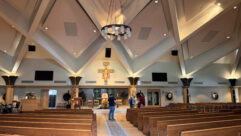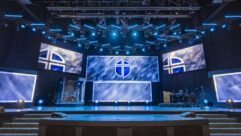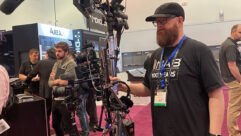
Rigging the Right Way
May 1, 2004 12:00 PM,
By Andrew Martin
Loudspeaker cluster suspended from a wood beam using offset swivel ring fasteners on both sides.
Make no mistake: the A/V industry is lucky to have such a terrific rigging safety record. Much of this luck can be attributed to the skill of the founding fathers of entertainment rigging, a field that began just 40 years ago. When this small group of riggers first started to suspend sound systems and lighting systems in the air, much trial and error was performed in order to create a collection of safe rigging practices for the industry. Many of those practices remain in use today, but they are now validated with the industry-specific application of good engineering principles and calculations. Furthermore, today’s personal computer programs and dedicated structural engineering software products have made it fairly simple to model the most complicated structures with excellent precision. But no matter how complex the installation may be, a good understanding of the fundamentals will go most of the way to ensuring a secure installation. If one makes the time to think things through and refuses the temptation to cut corners on the rigging system, it can be done without fancy programs or expert consultants.
GET IT DONE
As with any overhead application, everything begins with the structure itself. How does one know if the building can support the load? Will that wood beam running down the center of the peaked roof support an additional 500 pounds? How about that concrete block wall — will it support 100 pounds of wallmount without eventually succumbing to fatigue? Without incorporating the services of a professional engineer, you won’t know the answers to those questions, so turn to an expert.
ASTM C3X5 Channel reinforcement attached to a ceiling joist.

There are creative ways to make this happen without the service costing colossal sums of nonbid money. If the project is a church, try asking for someone in the congregation to donate the services to the church as a tax deduction. If the project is new construction, ask the general contractor to run it through the architectural firm. Or if you just don’t want to deal with it, make sure to cite the requirement and then exclude the structural engineering in the bid proposal. It doesn’t matter how it gets done — as long as it gets done.
But it is not enough to have a professional engineer verify that the structure will support the actual load. The engineer also needs to consider a design factor for the installation. The entertainment industry uses a minimum design factor of 5:1 for all overhead applications. That is very different from the traditional 1.5:1 design factors found in most building codes. A design factor is a ratio between the ultimate strength of a component and the load rating of that same component. The load rating is called a
working load limit
(WLL). To figure out the WLL of a component that breaks at 1,000 pounds, the following formula would be used:
WLL=200 pounds
One consideration is an attachment to a building with an appropriate method that will be strong enough to support the load and inconspicuous enough to generally please the client. That can be a difficult task if the venue is a museum-quality piece of architecture. Regardless of the aesthetic constraints, many pieces of hardware will do the job well. Look around at reliable rigging sources: you are bound to find the right fit for the project. However, use only product-traceable hardware that is rated for overhead suspension. Hardware that is not product traceable and not specifically rated for overhead suspension will not limit your liability exposure. If the hardware fails for any reason, you will be held liable. If that statement is unsettling, it’s because it’s a very real danger.
THREE STEPS TO SAFETY
It’s simple to mitigate your liability to almost zero. All that’s necessary to manage your risk is three simple steps: use only product-traceable hardware that is specifically rated for overhead suspension, employ hardware in strict accordance with the manufacturer’s instructions, and maintain the hardware in strict accordance with the manufacturer’s instructions or be sure to contractually forward the maintenance obligation to the purchaser.

At this point, with a mere three best practices, the vast majority of potential accidents with the rigging installation have been eliminated. All that remains is the functional particulars of actually performing the installation in such a way that everything will be secure. The key to providing just such an installation is to keep a simple and direct approach to the rigging system. The more complicated the contraption, the more opportunity there is for error and for failure. If the installation requires a complicated approach, then extra care needs to be taken in execution. However, if the installation is not a complicated one, keep the rigging system appropriate for the job.
When you are shopping for rigging systems, look at the various manufacturers throughout the world. Purchase a system rather than fabricating your own, and use only product-traceable hardware that is rated for overhead suspension. It is too important to leave the fabrication of a life-endangering device to anyone other than a rigging fabrication expert. Know your limitations and know when to say no. That wisdom could save a life.
Enough of the broad strokes: important as they are, the hardware is still in the box, and it needs to be put together in a safe way that will produce the results stipulated in the design of the rigging system. By now you should have had a professional engineer analyze the building for strength and safety, applied at minimum 5:1 design factor, obtained product-traceable and overhead suspension rated hardware, and designed a system that is as simple as possible. You should also be confident that you can perform this installation without sacrificing safety.
RIGGING COMPONENTS
The time has come to assemble the hardware in strict accordance with the manufacturer’s instructions and with the best rigging practices available. The best way to communicate some of the best rigging practices is to separate the hardware components of a typical rigging installation.
Five-inch diameter washers reinforcing three wallmount bolt fasteners installed through the wall.b<

Structural reinforcementsSteel must be of a structural grade such as ASTM A36, A500B, or C1018, because those materials have minimum ultimate strengths that can be used by a professional engineer to determine an accurate design factor for the installation. Steel is excellent in tension and shear, and some shapes are excellent in torsion, as well. Steel is the material of choice for structural reinforcement applications.Wood structures must always be calculated by a professional engineer because wood is good, but not excellent, in torsion, tension, shear, and compression. Wood is also an organic product and cannot be calculated with precise results.Concrete, brick, and block are excellent in compression but poor in tension, torsion, and shear. Additional reinforcement can be added to concrete to build an efficient structure.Strut systems must be installed per the manufacturer’s instructional guidelines, usually creating a strut assembly footprint four to five times larger than the suspended load and intersecting at least four separate structural attachments on the building.Fasteners, anchors, and rodsBolt fasteners must be rated in order to accurately calculate the strength of the rigging system. SAE Grades 5 and 8 are generally the best choices for high-strength applications in shear, double shear, and tension. Alloy fastener strength varies with the manufacturer and alloy type, so one must investigate the fastener before incorporating it into the design. Stainless-steel lag bolts are available for applications that demand a blind fastener.Anchors are different from fasteners. Only anchors are to be used for structural applications in which calculations must be performed. A variety of anchors are available for use with various concrete mixtures, brick, mortar, and hollow walls. Additionally, there are different anchors for load directions in shear versus tension.Only strength-rated threaded rods and rod shafts must be used. Rods are graded for strength such as AISI 300 A193 Grade B7 or SAE Grade 8. Most threaded rod available at local hardware stores or electrical supply houses are not of a structural grade.Wallmounts and bracketsIf the load is going to be over people, the wallmount or bracket must be rated for overhead suspension. Attaching a wallmounted system overhead requires the same principles as a suspended system. Once final focus is achieved, adjustment of the wallmounted hardware should become fixed.Wire rope, chain, and rigging accessoriesAll rigging hardware should be marked with the WLL of the component using a minimum of a 5:1 design factor. Wire rope lifting slings and all chain slings must be permanently marked with an OSHA tag stating sling strengths. Wire rope static suspension slings do not require an OSHA tag, and all chain slings require an annual proof test and retagging.Rigging accessories with parts that may come loose must be secured. Screw pin anchor shackles should only be finger-tight, and then a mouse wire should be installed from the pin through the shackle body to prevent the pin from backing out.Turnbuckles should be tightened only with a wrench located on the specially located hexagonal sections of the turnbuckle intended for this use. Once adjusted the turnbuckle should be secured from loosening with a mouse wire between the end and the body of the turnbuckle.Quick links and steel carabiners must have locking gates and be installed such that the gate cannot loosen. That can be achieved by proper orientation of the hardware or by applying a drop of thread lock adhesive. Forged shoulder eyebolts should be loaded only in the plane of the eye at all times. Hoist rings and offset swivel ring fittings should be installed with a drop of thread lock adhesive.Lifting hooks should possess automatically closing gates to prevent the load from slipping off the hook tip. Wire rope clips need to be installed with the saddle on the live end of the wire rope and the nuts torqued properly. A load should be applied to the sling, and then the nuts should be retorqued.Wire rope compression sleeves should be installed and then checked with a go gauge to ensure proper compression. Banding and tension slings should not be over-tightened in order to prevent accidental breakage and possible long-term fatigue.Suspension grids, trusses, and beamsSuspension grids, trusses, and beams should be loaded in such a way as to keep the loading consistent across all of the suspension points if possible. Hardware should be kept flat and stable. Large systems require extra care in preventing an overload condition from occurring during assembly. Grids, trusses, and beams will change position as the loads underneath them change: keep personnel clear of pinch points and swinging pendulums during assembly.Sound equipment, video equipment, and lighting equipmentRigging systems that are adjustable should be carefully checked for loose fasteners and components after final adjustment has been completed. Loads must be stabilized at all times. Never allow the center of gravity to be above the stabilization point, or the load may flip over.Moving systems should be checked and rechecked before allowing people within the operating zone. Never move loads while people are underneath them. Should any modification become necessary to make the installation happen, get authorization from the manufacturer before making any modifications.AVOIDING ACCIDENTSSafe working practices are as vital as proper rigging hardware design and appropriate rigging components are. Rigging accidents occur due to errors in installation far more frequently than they do because of hardware failure. Usually, these errors in installation are caused because the installer is preoccupied with working in a high-risk environment, and he or she wants to get the job done fast and then get out. Therefore, anything that can be done that will reduce the stress level of the installer will create a more safe installation.Before starting any installation of rigging hardware, you must secure the area from passersby as well as prepare the installers for a safe and productive installation. In addition, only qualified personnel should be working on any rigging system.A stop-work procedure should be in place and understood by all so that in the unlikely event of an accident, everyone knows what to do, and a bad situation does not get worse. Anyone climbing above head height must be wearing OSHA-approved fall protection and needs to be trained on the proper use of the equipment.Tools that may fall from an installer’s hands while working overhead should be secured with a lanyard. Communication must be free-flowing and clear. Installers need to understand that they are expected not to take a risk at any time; if they are confused or inexperienced with anything at any time, they must know to stop and ask for clarification.In addition to the practices listed previously, you must abide by many standards and ordinances (depending on the location of the work being performed). For common standards that are adopted into U.S. law, almost without exception, see the sidebar, “Know the Standards.”ON THE SAFE SIDEThere are also ongoing efforts to create rigging standards for the entertainment industry through the Entertainment Services and Technology Association Technical Standards program. Information about this program can be found at www.esta.org. These efforts are important to sustain the A/V industry’s excellent safety record. While the industry has been lucky so far, it should be in no doubt as to the outcome of a rigging system installation.It is our duty, as professionals, to be responsible to the industry and to our clients and employees. By compiling a repertoire of best practices, we are behaving conscientiously and appropriately.Andrew Martinis president and chief executive officer of the ATM Group. He can be reached at[email protected].Know the StandardsBefore tackling your next A/V rigging project, be sure you’re familiar with the following safety standards.
- OSHA worker’s safety standards
- OSHA equipment standards 1910.184 and 1926.251
- ANSI overhead suspension equipment standards E1.2-2000
- ASME overhead suspension equipment standards B30.20
- Uniform Building Code structural standards section 1600
- UL equipment standards 1480.31.3










